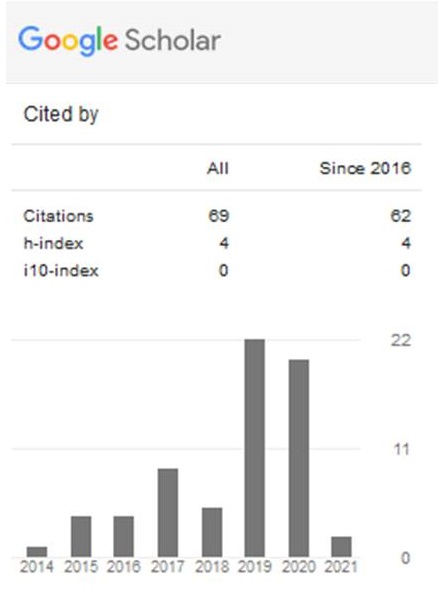Relation of The Difference of Water Level Toward Content of Cu and Zn Leave and Growth of Oil Palm Plants (Elaeis guineensis Jacq.) in the Peatlands
Abstract
Peatland is an important natural resource for human life because it can be used as media of oil palm plantation. The growth of oil palm plantations in peatlands is strongly influenced by peat water management. This study aims to study the relationship of different water levels to the content of leaf Cu and Zn nutrients and the growth of oil palm plants (Elaeis guineensis Jacq.) in the peatlands. This research has been carried out on peatland areas in oil palm plantations of PT. Jatimjaya Perkasa Sei Bangko, Kubu District, Rokan Hilir Regency, Riau Province. Analysis of soil samples and plants samples has been carried out at the Soil Laboratory, Faculty of Agriculture, Universitas Riau, Pekanbaru. The research was conducted in December 2017 to January 2018. This research was conducted using a survey method, the determination of the location of the study using a purposive sampling method, determination of sampling location is determined by stratified sampling method, where the strata in this study are grouped according to different peat water levels namely water level < 40 cm (TM 1), 40 - 60 cm (TM 2) and > 60 cm (TM 3) with oil palm plants at the same age which is six years. The parameters that observed in this study were soil pH, availability of Cu and Zn nutrient, total K-soil, content of Cu, Zn and K leaves and growth of oil palm plants which included plant height, midrib length and leaflet. The observed data were analyzed for variance and tested further by DNMRT at the level of 5%, then analyzed by regression to see the relationship between water level and parameters. The results showed that peatland with water level of 40 - 60 cm had a soil pH, K-total soil, Cu leaves, Zn leaves, midrib length and the highest oil palm plantations compared to peat land with a groundwater level < 40 cm and > 60 cm, and has a not different length of leaves.
Keywords
Full Text:
PDFReferences
Agus, F. dan I.G.M. Subiksa. 2008. Lahan Gambut: Potensi untuk Pertanian dan Aspek Lingkungan. Balai Penelitian Tanah dan World Agroforestry Centre (ICRAF). Bogor
Albari, J., Supijatno dan Sudradjat. 2018. Peranan pupuk nitrogen dan fosforpadatanaman kelapa sawit (Elaeis guineensis Jacq.) belum menghasilkanumur tigatahun. Bul. Agrohorti 6 (1) : 42-49
Damanik MMB; BE Hasibuan; Fauzi; Sarifuddin & Hamidah Hanum. 2011. Kesuburan Tanah dan Pemupukan. USU Press. Medan
Dinas Perkebunan Riau. 2013. Luas Perkebunan Kelapa Sawit di Lahan Gambut. Pekanbaru
Gardner. 1991. Fisiologi Tanaman Budidaya. UI Press: Jakarta.
Hakim, N. M. Y. Nyakpa, A. M. Lubis, S.G. Nugroho, M.R. Saul, M.A, Diha, G.B. Hong, H.H Beriley. 1986. Dasar-Dasar Ilmu Tanah. Penerbit Universitas Lampung. Lampung.
Hapsoh, Wawan, I. Rahmadini, J.A. Siregar. 2017. Compatibility tests of potential cellulolytic bacteria and growth optimization in several organic material. J. Appl. Sci. Tech. 2:26-3.
Khaswarina, S. 2001. Keragaan bibit kelapa sawit terhadap pemberian berbagai kombinasi pupuk di pembibitan utama. Jurnal Natur Indonesia. 3(2):138-150.
Lubis, A.U. 1992. Kelapa Sawit Di Indonesia. Pusat Penelitian Perkebunan Marihat Pematang Siantar, Sumatera Utara.
Mangoensoekarjo, S. 2007. Manajemen Agrobisnis Kelapa Sawit. Gadjah Mada University Press. Yogyakarta.
Melling, L.R. Hatano, and K.J. Goh. 2005. Soil CO2 flux from three ecosystem in tropical peatland of Serawak, Malaysia. Tellus B: Chemical and Physical Meteorology, 57: 1-11.
Moorman, F. R., and van Breemen, N., 1978. Rice: Soil, Water, Land.
International Rice Research Institute, Los Banos – Philippines.
Nurlaeny, N. 2015. Bahan organik tanah dan dinamika ketersediaan unsur hara tanaman. Unpad Press, Bandung
Page S.E., J.O. Rieley and C.J. Banks. 2011. Global and regional importance of the tropical peatland carbon pool. Glob Change Biol. 17(2):798-818.
Pahan, I. 2011. Panduan Lengkap Kelapa Sawit. Penebar swadaya: Jakarta.
Palar,H., 1994, Pencemaran dan Toksikologi Logam Berat. Rineka Cipta, Jakarta.
Prabowo, R. dan R.Subantoro. 2017. Analisis Tanah Sebagai Indikator Tingkat Kesuburan Lahan Budidaya Pertanian di Kota Semarang. Cendekia Eksakta. 2(2):59-64.
Rini, N. Hazli, S. Hamzar, dan B.P. Teguh. 2009. Pemberian Fly Ash pada Lahan Gambut untuk Mereduksi Asam Humat dan Kaitannya Terhadap Kalsium (Ca) dan Magnesium (Mg). J. Teroka, 9(2): 243-154.
Rosmarkam, A. dan N.W. Yuwono. 2002. Ilmu Kesuburan Tanah. Kanisius, Yogyakarta.
Sabiham, S. 2000. Kadar air kritik Gambut Kalimantan Tengah dalam kaitannya dengan kejadian kering tidak-balik. J. Tanah Trop. 11:21-30
Sabiham, S. dan Sukarman. 2012. Pengelolaan lahan gambut untuk pengembangan kelapa sawit di indonesia. J. Sumberdaya Lahan (6):2:55-66.
Sabihan, S. G., Soepardi dan Sukardan D. 1990. Pupuk dan Pemupukan. Departemen Ilmu–Ilmu Tanah. Faperta IPB. Hal 35–37.
Sahputra, R. 2016. Pengaruh Kedalaman Muka Air Tanah dan Bahan Organik Terhadap Ketersediaan Hara dan Pertumbuhan Tanaman Kelapa Sawit (Elaeis guineensis Jacq) di Lahan Gambut. Skripsi (Tidak dipublikasikan). Universitas Riau. Pekanbaru.
Sahputra, R., Wawan, E. Anom.2016. Pengaruh kedalaman muka air tanah dan bahan organik terhadap kesediaan hara dan pertumbuhan kelapa sawit (Elaeis guineensis Jacq) di lahan gambut. JOM Faperta. 3 : 1.
Salampak, 1999.Peningkatan Produktivitas Tanah Gambut yang Disawahkan
dengan Pemberian Bahan Amelioran Tanah Mineral Berkadar Besi
Tinggi. Disertasi Program Pascasarjana, Institut Pertanian Bogor.
Sarwar, M. 2011. Effects of zinc fertilizer application on theincidence of rice stem borers (Scirpophaga species) (Lepidoptera: Pyralidae) in rice (Oryza sativaL.) crop. J. of Cereals and Oilseeds. 2(5):61-65.
Siagian, 2016. Distribusi Fe, Cu Dan Zn Pada Lahan Gambut Perkebunan Kelapa Sawit Berdasarkan Jarak Dari Batang Dan Ketebalan Gambut Pada Musim Hujan. Tesis. Program Pascasarjana IPB. Bogor.
Siallagan, E.J. dan Wardati. 2015. Efektivitas Pupuk Majemuk dan Cu Terhadap Pertumbuhan Vegetatif Tanaman Kelapa Sawit (Elaeis guineensis Jacq.) di Lahan Gambut. Universitas Riau. Pekanbaru. Tidak dipublikasikan
Situmorang, P. C. 2015. Pengaruh Kedalaman Muka Air Tanah dan Mulsa Organik terhadap Sifat Fisik dan Kimia Tanah Gambut pada Perkebunan Kelapa Sawit (Elaeis guineensis Jacq). Skripsi (Tidak dipublikasikan). Universitas Riau. Pekanbaru.
Soepardi, G. 1982. Sifat dan Ciri Tanah. Depertemen Ilmu ilmu Tanah Fakultas Pertanian. IPB. Bogor.
Sosiawan, H. 2014. Variasi Temporal dan Spasial Tinggi Muka Air Tanah Gambut. Balai Penelitian Agroklimat dan Hidrologi. Bogor.
Subiksa, I G.M. 2000. Ameliorasi Lahan Gambut Untuk Usaha Tani yang Berkelanjutan. Dalam Prosiding Seminar Nasional Penelitian dan Pengembangan Pertanian di Lahan Rawa. Cipayung, 25-27 Juli 2000.
Suwondo, S., Sabiham., Sumardjo., dan B. Paramudya.2011. Efek Pembukaan
Lahan terhadap karakteristik Biofisik Gambut pada Perkebunan Kelapa Sawit di Kabupaten Bengkalis. Jurnal Natur Indonesia, 14 (2):143-149.
Tan, KH. 2000. Environmental Soil Science. MarcelDikker Inc. New York. 360 p
Wahyunto, S. Ritung, Suparto, dan H. subagyo, 2005. Sebaran Gambut dan Kandungan Karbon di Sumatera dan Kalimantan. Proyek Climate Change, Foresta, and Peatlands in Indonesia. Wetlands International. Indonesia Programme dan Widlife Habitat Canada. Bogor.
Refbacks
- There are currently no refbacks.

_2017.jpg)



